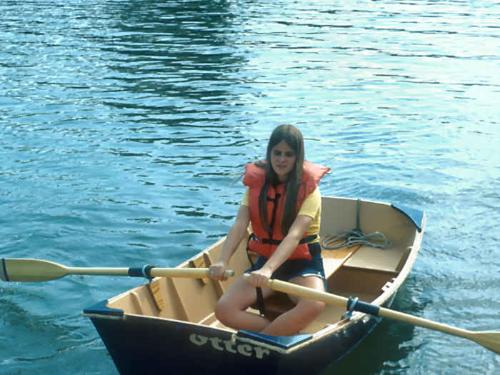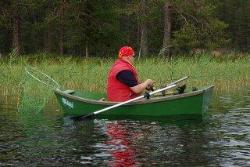Redrawing Wm Atkin's 'Tiny Ripple'
|
This post was updated on .
Sometime in the '30s, Wm & John Atkin drew a 6' punt intended as a tender/lifeboat to be carried aboard smallish yachts.
 They estimated costs (lumber, paint, hardware, oars and equipment) at $35. So you know how long ago that was. The drawings place the waterline exactly at the intersection of the transom with the bottom, as shown below. However, that waterline can only be achieved if 'total displacement' --boat, equipment, passengers, and cargo-- is less than 160 pounds!  Opps. The boat alone --if built to their material list and scantlings-- is 70 pounds. So if a single user weighs more than 100, the stern will drag, which isn't a problem if the boat is only moving a dozen yards from an anchorage to a dock or beach. But if a "normal" adult weighs 100 pounds --plus 5 pounds for every inch over 5' feet -- and he/she wants to haul fuel, fresh water, and groceries without dragging the stern, the rocker needs adjusting. If the rocker needs redrawing, then what other problems might the original set of plans have? So, this is the challenge that will be addressed in this thread: "How much of Atkin's lines/plans can be kept, and what really does need changing?" The rocker needs to be changed, and if the planking and framing were changed --they used 1/2" white cedar and famed with mahogany (or apple)-- the boat's weight could be cut in half. OTOH, I really, really like 'the look' of the boat and its sturdiness, burdensomeness, and functionality. Plus, as drawn with storage/floatation compartments fore and aft, the boat is unsinkable. I think 'Tiny Ripple' deserves to be built. Apparently, others do, too. The first example stays close to Atkin's lines/and methods, but seems to eliminate the compartments. The second keeps the compartments, but is a S&G hack job. [Using epoxy fillets to stick boat parts together can be justified only when they offer a true advantage over traditional methods. Those corner knees and thwarts are sloppy and inexcusable.] Charlie |
|
This post was updated on .
The chief constraint the Atkins imposed on the design of Tiny Ripple was that the boat would fit on the foredeck --or in the cabin-- of a smallish yacht. They also required that the boat serve as a 'lifeboat', not merely a 'tender'. But that's a matter of compartmenting, not overall length or beam.
If length is kept to 6', then the bottom, both transoms, and one side can be cut from a single sheet of ply, with the other side requiring just another one-third sheet. This makes for a minimalist build, but creates an "aesthetics" problem if the boat is to be finished bright, because no two sheets of ply ever match each other in color and figure. The "proper" solution is to cut the bottom from one sheet and the sides and transoms from another. But once that is allowed --and the boat isn't intended to be carried on a smallish yacht-- there's no reason to keep the length to 6'. But once no constraint is put on length, most of the uniqueness of Tiny Ripple is lost. So, what's a good compromise between putting as much length on the waterline as possible --to gain hull speed and burdensomeness-- but keeping length as short as possible --consistent with intended usage and passenger loads-- in order to make the boat easier to build and transport/store? Due to the curves that define each hull type, 7'6" is about as much of a 'skiff' as can be cut from a standard sheet of ply without scarfing planks; about 7'8" for a 'pram'; and 7'10" for a 'punt'. But a punt that is 94" long --vs Tiny Ripple's 72"-- is no longer "tiny", and I've already drawn --and put on the water-- a 7'10" punt that proved to handle well, my Lake Britton design, a pair of which I donated to a kids' summer camp, but not before fishing them hard for a week and discovering they really were good boats. I've also done a 7' footer, but didn't keep it, because it really was too small for me (at 5'6" and 120#). But if 84" is too short, then 72" is ridiculously short *unless* it's meant as a kid's boat, and not a marine clown car.  The first photo is an overloaded Tiny Ripple. The second, CLC's more burdensome, but equally overloaded, Eastport Ultralight Dinghy, and both are egregious examples of irresponsible seamanship. The next photo --Tiny Ripple, again-- is more what I have mind. Clearly, she's not comfortable in the boat or with rowing. But boat isn't egregiously too small for her.  Frankly, kid's boats appeal to me, Hannu's Portuguese Dinghy especially.   http://hvartial.kapsi.fi/dinghy1/gallery/gallery.htm I built one --painted lime green and white-- and used it for a season before chainsawing it. But it's not a hull form I want to revisit, for not much liking the design and construction problems that skiffs create. OTOH, a short punt might be fun. So I should stick with Ripple's offsets as closely as it makes sense to do so, and then find some skinny, little kid to give it to. That means building a boat meant to be painted, not finished bright, which frees up how planks have to be laid out, as well as encourages making use of 1/8" ply and WRC. Charlie |
|
This post was updated on .
The Atkins specify 5-foot oars for Tiny Ripple, which is too short by a foot, given its 42" beam, even if the oars aren't overlapped --as they should be-- and leverage is increased to 29% (instead of Shaw & Tenney's recommended 28%).
Now, here's the reality. People hate to row, because they're given bad equipment: the oars are too short for the boat; the blade is too heavy for the rower; the loom isn't indexed; and the grip causes blisters. The solution for a kid's boat used by inexperienced rowers is a properly-shaped grip, a pinned loom, a balanced blade, and increased leverage. So my version of Tiny Ripple will be furnished with 6's, geared at 32%, which gives me the opportunity to swap a bit of beam for length, thus, maintain the same displacement, but gain a bit of speed AND make the oars easier to stow (which was a concern of the Atkins and their reason for selecting 5.0s.) |
|
In reply to this post by Charlie43
That's an interesting little boat. With today's materials it could be built a little bigger (to address the loading you mentioned) while still being a lot lighter. The plastic hatches on the s&g boat allow stowage while preserving the floatation chambers. Pretty cool!
Mark |
|
Mark,
The hatches are an essential feature of the design, because Ripple was intended to be a 'lifeboat, i.e., a means of surviving until rescued if the mothership sank and not just a 'tender' and means to get the the yacht club bar when in harbor. I'm of mixed minds whether to build the boat, mostly because I think it should be painted, not varnished, and I HATE painting boats. If I do build it, I'd use use an external chine. If done that way, a one-day build becomes possible, which has its appeal. Charlie |
«
Return to General discussion
|
1 view|%1 views
| Free forum by Nabble | Edit this page |

